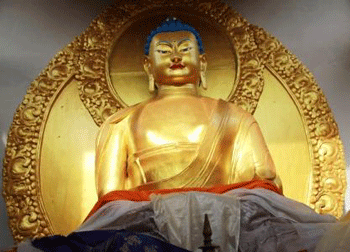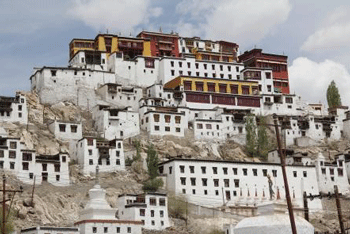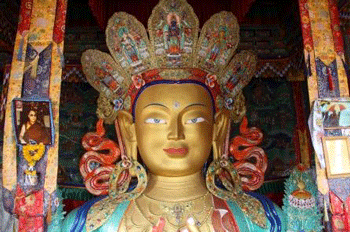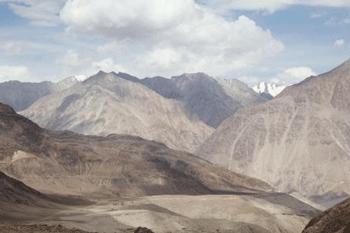Spiritual awakening in the land of the gompas
By Swetha Amit | 25 Jan 2012
Some places offer exciting wildlife, while others are known for their bountiful beaches and tropical weather. A few boast magnificent sand dunes and others leave you gaping in awe at their mighty mountains. Serenity and awe battled for dominance as we drove past barren terrains, mountain passes at an altitude of 18,000 feet above sea level and lonely monasteries in a wonderful land called Ladakh.
 A vast wall of mountains greeted us as we drove down from the airport to our hotel. We were allowed a few hours of rest after our long journey to the Himalayan destination. We were told that we would require some time to acclimatise ourselves to low oxygen levels in Leh. We set off in the evening to explore Shanti Stupa and the Leh Bazaar.
A vast wall of mountains greeted us as we drove down from the airport to our hotel. We were allowed a few hours of rest after our long journey to the Himalayan destination. We were told that we would require some time to acclimatise ourselves to low oxygen levels in Leh. We set off in the evening to explore Shanti Stupa and the Leh Bazaar.
Sojourn with serenity: The Shanti Stupa was built by Japanese Buddhists to promote peace, and inaugurated by the Dalai Lama in 1983. It was a steep climb to the stupa. Surrounded by mountains and glistening in the setting sun, the stupa was a treat for the sore eyes. Symmetrical in shape, the stupa had a statue of Buddha standing guard. After paying homage, we walked around the area taking in the picturesque surroundings. We could see the entire village of Leh from there. After clicking a few photographs, we proceeded towards Leh Bazaar.
Souvenirs and shops: Leh Bazaar bustled with activity. Many shops sold souvenirs, caps, shawls and Buddhist prayer bells. We noticed that the locals resembled Tibetans. Not surprisingly, many of the residents had migrated from Tibet years ago. They were simple folk, friendly, and peace-loving.
The souvenir shops had statues of Buddha in all shapes and sizes, prayer bells, purses, T-shirts portraying the pride of Ladakh, jewellery and caps. We were taken aback by the prices; most of the items cost Rs500 or more. They seemed overpriced, but careful selection gave us our money’s worth. We then headed back to the hotel for a good night’s sleep.
 Carving of the five Buddhas: We set off on a spiritual quest the next day. Ladakh is famous for its monasteries, and there is history attached to each. We drove down winding roads in sight of mountains in various hues, like an artist’s wide strokes on canvas. Our first stop was the Shey Palace. It was one of the ancient capitals of Ladakh.
Carving of the five Buddhas: We set off on a spiritual quest the next day. Ladakh is famous for its monasteries, and there is history attached to each. We drove down winding roads in sight of mountains in various hues, like an artist’s wide strokes on canvas. Our first stop was the Shey Palace. It was one of the ancient capitals of Ladakh.
As we approached the palace from Leh, we spotted the spectacular rock carvings of the ‘Five Buddhas’. They were carved in the early Indian Buddhist style and are credited to King Nyimagon. The palace gompa (monastery) contains an 8-metre statue of Sakyamuni Buddha. When we entered the sanctuary, we were actually entering the second floor and found ourselves at the level of the statue’s shoulders. The walls were decorated with paintings. Beyond the palace is a small group of stupas or chortens. Each had a design with a symbolic meaning. Those who wished to stay the night in Shey had several guesthouses to choose from.
Exotic gompa: As we approached Thikse, we saw a sight which was probably close to illustrations in fairy tale books. The vibrancy of the multi-coloured structure left us awestruck. It looked exactly how an exotic gompa would look like in our imagination. Built across the slopes, it resembled a village in itself.
The gompa was famous for a beautiful giant statue of Maitreya. Maitreya is the Buddha of the next age, popularly known as the ‘Future Buddha’. Here, as in Shey, we entered on the second floor and found ourselves standing level with the statue’s shoulders. The statue, made of terracotta bricks and clay and painted gold, is 12 metres tall. We paid our homage but were not allowed to pose alongside the statue. As we climbed up, we found prayer bells on the way, which we rotated chanting the Buddhist mantra. At the top, we enjoyed a magnificent view of the Indus valley before descending.
 The gompa of vibrancy: Situated in a small side valley in the Stok range was the Hemis Gompa. It is quite close to the village of Hemis. This is the most famous gompa in Ladakh, where the annual Hemis Gompa festival is held during the summer months of June-July. The festival features a dance drama called ‘Chams’ performed by monks in colourful robes and grotesque masks.
The gompa of vibrancy: Situated in a small side valley in the Stok range was the Hemis Gompa. It is quite close to the village of Hemis. This is the most famous gompa in Ladakh, where the annual Hemis Gompa festival is held during the summer months of June-July. The festival features a dance drama called ‘Chams’ performed by monks in colourful robes and grotesque masks.
It was an elaborate structure with painted verandas protruding from the upper floors. A row of prayer wheels went up the steps leading to the main area where the deities were present. We paid our respects to the beautiful statue inside and visited the treasury below, which had different statues and objects representing Buddhism. We also visited the souvenir shop for gifts.
 School of monks: On the way back to Leh, we visited a school affected by the cloudburst that occurred in August 2010. The school, where the famous Bollywood movie ‘3 Idiots’ was filmed, had a resplendent sunflower garden. Some of the monks obliged us by posing for photographs.
School of monks: On the way back to Leh, we visited a school affected by the cloudburst that occurred in August 2010. The school, where the famous Bollywood movie ‘3 Idiots’ was filmed, had a resplendent sunflower garden. Some of the monks obliged us by posing for photographs.
We learnt that anyone could become a monk irrespective of age, but that they need to be well versed in Buddhism which was taught in the schools. Restoration was on at parts that were most affected by the floods. After an interesting day, we headed back to our hotels to get a good night’s rest before proceeding to Nubra Valley the next day.
How to reach Leh
By air: Several airlines operate from Delhi, Jammu and Srinagar.
By road: Adventure lovers usually opt for the road journey from Delhi, Srinagar and Manali. There are several buses operating from these places.
Best time to visit
The best time to visit Leh would be between the months of June and September. In winter, the temperatures often dip below zero degrees.
Cost
- A week’s stay in Leh would cost anywhere between Rs18,000-25,000 per person, excluding airfare.
- One can also opt to camp in Nubra Valley, Pangong Lake or any of the monasteries. The cost would range from Rs3,000-4,000 per person, all meals inclusive.
Essentials and guidelines
- One must adhere to monastery rules and maintain silence while visiting the gompas.
- Do not take photographs along with the statues of Buddha as it is considered offensive.
- Remember to take sufficient warm clothing as the drive up the mountain passes can be extremely cold with snowfall.
- Frequent power cuts are common in Leh; a torch will be useful if one decides to camp overnight.
Also read: The valley of illusion






























